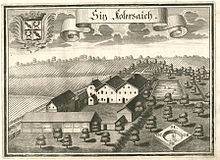Noble seat Kollersaich

The noble seat Kollersaich was in the Lower Bavarian municipality of Massing in the district of Rottal-Inn.
history
Kollerseich was owned by the Scharfsöder dynasty , these descend from the electoral knight's fief in Linden, a district of Hebertsfelden . In 1407 a Stephan Scharffeder zu Kollersaich was named. In 1455 a Hanns Scharfsöd zu Kolasaich is mentioned in the Eggenfelden court . This family stayed here until the middle of the 18th century. The last mentioned in the country table from 1752 was Maria Josefa Freiin von Scharfsed , who remained unmarried . In 1560 and 1737 a seat and a sedel are mentioned here, i. H. Kollerseich was a Hofmark .
From 1760 Maximilian Freiherr von Berchem was entered in the farm register. He was related to a Maria Anna Franziska Freiin von Scharfsed auf Kollersaich , née von Schleich, whom Kollersaich bequeathed to him in her will (1756). He was succeeded by Maria Theresia Eleonora Countess of Ceßana et Colle on Langquart and Ponbruck in 1780 . The aunt of Maria Anna Franziska was one of Guggenmoos, born of Colle. After the death of Maria Theresa Eleonora in 1788 the seat was inherited by Siegmund Freiherrn von Gugomos auf Geistdorf . From this, Josef Anton Graf von Jonner bought the property and the local court on July 23, 1794. The patrimonial court was withdrawn by the state on April 10, 1835, because the owner of the Hofmark, Count Jonner von Doß , could not pay the Dominical taxes and the district levies.
Construction
From 1818 to 1823, Kolleraich belonged to the Eggenfelden district court and the Wolfsegg II community and subsequently shared the fate of this community.
After the engraving by Michael Wening , Kollerseich was a complex consisting of three assembled houses. One of them has a cripple hipped roof and should be referred to as the manor house. U. U. the other two buildings are the Sedelhof von Kollerseich mentioned in 1560 and 1737. The ensemble forms a rectangular courtyard with other rural buildings. The complex seems to have been expanded, possibly an indication of a lower castle that used to exist here . There is a square pond next to the buildings, behind which there are gardens.
literature
- Rita Lubos: The Eggenfelden district court , pp. 111–112. (= Historical Atlas of Bavaria, part of Altbayern issue 28). Commission for Bavarian History, Verlag Michael Lassleben, Munich 1971, ISBN 3-7696-9874-6 .
Coordinates: 48 ° 23 '18.7 " N , 12 ° 36' 13.9" E

